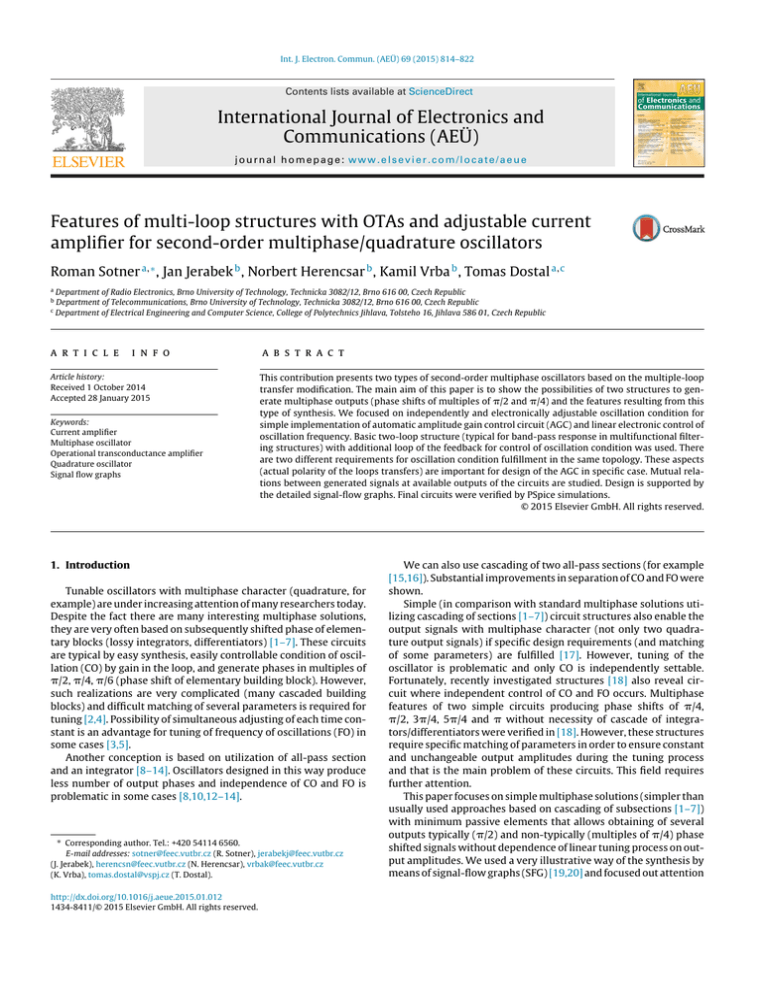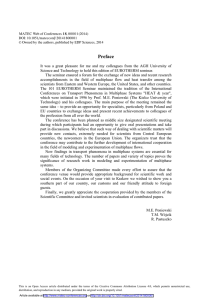
Int. J. Electron. Commun. (AEÜ) 69 (2015) 814–822
Contents lists available at ScienceDirect
International Journal of Electronics and
Communications (AEÜ)
journal homepage: www.elsevier.com/locate/aeue
Features of multi-loop structures with OTAs and adjustable current
amplifier for second-order multiphase/quadrature oscillators
Roman Sotner a,∗ , Jan Jerabek b , Norbert Herencsar b , Kamil Vrba b , Tomas Dostal a,c
a
b
c
Department of Radio Electronics, Brno University of Technology, Technicka 3082/12, Brno 616 00, Czech Republic
Department of Telecommunications, Brno University of Technology, Technicka 3082/12, Brno 616 00, Czech Republic
Department of Electrical Engineering and Computer Science, College of Polytechnics Jihlava, Tolsteho 16, Jihlava 586 01, Czech Republic
a r t i c l e
i n f o
Article history:
Received 1 October 2014
Accepted 28 January 2015
Keywords:
Current amplifier
Multiphase oscillator
Operational transconductance amplifier
Quadrature oscillator
Signal flow graphs
a b s t r a c t
This contribution presents two types of second-order multiphase oscillators based on the multiple-loop
transfer modification. The main aim of this paper is to show the possibilities of two structures to generate multiphase outputs (phase shifts of multiples of /2 and /4) and the features resulting from this
type of synthesis. We focused on independently and electronically adjustable oscillation condition for
simple implementation of automatic amplitude gain control circuit (AGC) and linear electronic control of
oscillation frequency. Basic two-loop structure (typical for band-pass response in multifunctional filtering structures) with additional loop of the feedback for control of oscillation condition was used. There
are two different requirements for oscillation condition fulfillment in the same topology. These aspects
(actual polarity of the loops transfers) are important for design of the AGC in specific case. Mutual relations between generated signals at available outputs of the circuits are studied. Design is supported by
the detailed signal-flow graphs. Final circuits were verified by PSpice simulations.
© 2015 Elsevier GmbH. All rights reserved.
1. Introduction
Tunable oscillators with multiphase character (quadrature, for
example) are under increasing attention of many researchers today.
Despite the fact there are many interesting multiphase solutions,
they are very often based on subsequently shifted phase of elementary blocks (lossy integrators, differentiators) [1–7]. These circuits
are typical by easy synthesis, easily controllable condition of oscillation (CO) by gain in the loop, and generate phases in multiples of
/2, /4, /6 (phase shift of elementary building block). However,
such realizations are very complicated (many cascaded building
blocks) and difficult matching of several parameters is required for
tuning [2,4]. Possibility of simultaneous adjusting of each time constant is an advantage for tuning of frequency of oscillations (FO) in
some cases [3,5].
Another conception is based on utilization of all-pass section
and an integrator [8–14]. Oscillators designed in this way produce
less number of output phases and independence of CO and FO is
problematic in some cases [8,10,12–14].
∗ Corresponding author. Tel.: +420 54114 6560.
E-mail addresses: sotner@feec.vutbr.cz (R. Sotner), jerabekj@feec.vutbr.cz
(J. Jerabek), herencsn@feec.vutbr.cz (N. Herencsar), vrbak@feec.vutbr.cz
(K. Vrba), tomas.dostal@vspj.cz (T. Dostal).
http://dx.doi.org/10.1016/j.aeue.2015.01.012
1434-8411/© 2015 Elsevier GmbH. All rights reserved.
We can also use cascading of two all-pass sections (for example
[15,16]). Substantial improvements in separation of CO and FO were
shown.
Simple (in comparison with standard multiphase solutions utilizing cascading of sections [1–7]) circuit structures also enable the
output signals with multiphase character (not only two quadrature output signals) if specific design requirements (and matching
of some parameters) are fulfilled [17]. However, tuning of the
oscillator is problematic and only CO is independently settable.
Fortunately, recently investigated structures [18] also reveal circuit where independent control of CO and FO occurs. Multiphase
features of two simple circuits producing phase shifts of /4,
/2, 3/4, 5/4 and without necessity of cascade of integrators/differentiators were verified in [18]. However, these structures
require specific matching of parameters in order to ensure constant
and unchangeable output amplitudes during the tuning process
and that is the main problem of these circuits. This field requires
further attention.
This paper focuses on simple multiphase solutions (simpler than
usually used approaches based on cascading of subsections [1–7])
with minimum passive elements that allows obtaining of several
outputs typically (/2) and non-typically (multiples of /4) phase
shifted signals without dependence of linear tuning process on output amplitudes. We used a very illustrative way of the synthesis by
means of signal-flow graphs (SFG) [19,20] and focused out attention
R. Sotner et al. / Int. J. Electron. Commun. (AEÜ) 69 (2015) 814–822
on the utilization of the proposed structures for differential-voltage
mode operation. Many suitable active elements exist and were
reported in recent years [21]. We selected operational transconductance amplifiers (OTA) [21,22] and adjustable current amplifier (CA)
for the synthesis because they allow simple utilization in systems
without necessity of requiring resistors.
We compared known solutions of the similar electronically
controllable types of second-order oscillators based on OTAs and
several advanced devices based on OTA (partially), i.e. current differencing transconductance amplifiers (CDTA), voltage differencing
transconductance amplifiers (VDTA), current follower transconductance amplifiers (CFTA) and current conveyor transconductance
amplifiers (CCTA) – extensions of the OTA features by further active
elements [21] and our solutions from several aspects, see Table 1.
All the circuits (discussed in Table 1) allow at least one phase
shift (/2 in many cases). Our goal is to find electronically controllable solutions where multiphase (or differential) outputs are
available and unchangeable in voltage level under condition of
FO tuning which utilize minimal number of active and passive
elements and operate without requiring matching of parameters.
Many solutions have been compared in detail in Table 1 but they
have the following problems: (1) Some circuits employ 4 and more
active elements [23–29]; (2) Some solutions are electronically tunable only under very unsuitable conditions [8,30] (see notes in
Table 1); (3) Many of the studied circuits do not allow linear control of the FO [31–45]; (4) Many circuits allow linear control of
FO under disadvantageous matching condition only – not suitable in practice and for utilization of amplitude automatic gain
control circuit (AGC) [8,10,30,46]; (5) There exist several oscillators where all the generated output levels are independent on
linear tuning process [8,10,24–26,28,47–49] but almost none of
them have multiphase outputs (circuit in [47] has multiphase
outputs but produced signals seems to be influenced by CO control, circuit in [28] allows multiphase operation but structure is
too complicated); (6) Separated control of CO (by independent
parameter suitable for driving) of some solutions (typically in
cases discussed in point 6, 7, and 8) is not possible [8,10,30,46];
(7) A majority of solutions is not suitable for differential outputs
[8,10,23–27,29–34,36–43,48,49,51,52]; (8) A very small number
of studied types of circuits allow multiphase outputs (more than
2) [28,32,35,47] but output amplitudes of some of them vary if
FO is tuned [32,35] or do not allow differential outputs [32]; (9)
Phase shifts in multiples of /4 are possible in a limited number of known circuits (for example [17,18]) except complicated
multiphase (higher-order) solutions that employ cascading of integrator/differentiator lossy blocks (for example [7]). As conclusion
of such analysis we intended to synthesize second-order oscillator (recapitulation of required specification): (a) allowing linear
control of FO, (b) having completely independent parameter for
CO setting, (c) having multiphase output character of produced
signal (available also for differential/symmetrical operation) with
unchangeable output levels during the tuning process (FO change),
(d) providing the simplest circuit structure (minimal number of
passive and active elements).
Considering these points, we concluded that only two secondorder solutions (employing OTAs and OTA-based active elements
[28,47]) fulfill the main above given conditions (but with some
drawbacks). A solution introduced by Galan et al. [28] utilizes
four OTAs (differential output) and four capacitors. Four additional
voltage buffers for impedance separation of four high-impedance
output nodes (nodes of capacitors) in case of low-impedance loads
are required. Therefore, it is too complex. Circuit presented by Jaikla
et al. [47] seems to be useful and beneficial. The authors discuss
very simple realization (two active and two passive elements) but
output responses are available in form of currents only and further
current-to-voltage conversion with additional buffering is necessary. It seems that relations between produced output currents
can be influenced by the CO adjusting. In fact, each active element,
used in [47], consists of two subsections (current differencing unit
[21] and multiple-output OTA). Therefore, there is still scope for
improvements in complexity of solution if simple single-purpose
active elements (active elements without sub-partial composition
by simple active parts) are used.
Our proposal provides all featured benefits (a)–(d) in solutions
with minimal number of passive elements (capacitors only) and a
sufficiently low number of active elements (always two OTAs with
multiple outputs and one adjustable current amplifier). In comparison with the previously reported structures based on OTAs only
[23–29,44,47] our solutions utilize also additional current amplifier
beneficially. Our proposed structures are comparable to the simplest circuits that allow all the specified features simultaneously
[28] and remove some drawbacks of known similar circuits. Nevertheless, same as all other circuitries, also our circuits presented
in this paper require additional buffering of high-impedance nodes
to obtain low-impedance voltage outputs. Fortunately, as we will
see in further text, such buffering by special voltage buffer (noninverting and inverting output) can be also profitable in order to
ensure multiphase features.
The paper is divided as follows: Section 1 introduces recent
progress of the research in the field and shows imperfections of
available solutions that should be solved. A detailed comparison of
various hitherto published circuits is also given. Section 2 deals with
the OTAs and CA-based structures leading to featured advantages.
Detailed simulation results are shown in Section 3 and concluding
remarks are presented in Section 4.
2. Circuit structures
Our derivation is based on a very simple structure employing
only one multiple-output OTA and one single-output OTA together
with one current amplifier for CO control. A proposal of presented circuits was inspired by interesting work of [44] written by
Bhaskar-Abdalla-Senani. The authors proposed several structures
that require two functional current outputs of the OTA and employ
three active elements. Functional outputs mean a number of outputs required for interconnection between integrators and closing
functional loops in the circuit. OTA terminals for additional explicit
current outputs are not taken to this group (functional). However, a
lack of linear control of oscillation frequency in all the circuits proposed in [44] is evident. All there presented types have frequency
of oscillation equal to ω0 = (gm1 gm2 /(C1 C2 ))1/2 .
gm2
1/sC1 L2
B
L3
gm1
-gm2
L1
-gm1
1
-gm1
V1
L1
gm1
1/sC2
1/sC1 L2
2
V2
a)
815
B
L3
-gm1
1
gm1
V1
1/sC2
2
V2
b)
Fig. 1. SFG solutions of the OTA-based and adjustable current amplifier based quadrature oscillator that requires for CO: (a) B ≥ 1, (b) B ≤ 1.
ID
445999
Title
Featuresofmulti-loopstructureswithOTAsandadjustablecurrentamplifierforsecond-order
multiphase/quadratureoscillators
http://fulltext.study/article/445999
http://FullText.Study
Pages
9

